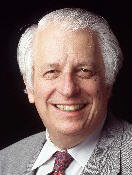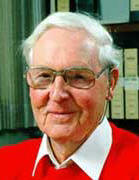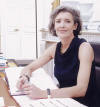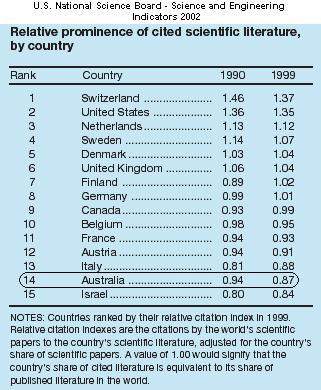The question of course duplication is bedevilled by
terminological confusion. The Issues Paper refers to duplication and
rationalisation in terms of fields of study, courses and units. The consequences
of duplication differ according to which of these is referred to. Thus, that the
field of "Business & Management" is offered at 37universities is neither
surprising nor undesirable given the huge demand for business degrees. One would
expect "popular" degrees to be offered in most institutions e.g. business,
education, nursing.
The convergence of the past 15 years, which in my view is
undesirable, relates not so much to course offerings, but rather to the
aspirations of all universities to offer advanced studies and research training
and to undertake research across all the disciplines in which they are involved.
This is the main way in which the newer institutions have mimicked the older
ones. Research and research training has been seen as prestigious and all
universities have sought to increase research enrolments and research funding;
and current funding arrangements have promoted this.
In my response to Crossroads (submission 14), I suggested
that institutional research funding should be on a disciplinary basis (not an
institutional one) and should take account of the volume and quality of the
outputs of the relevant research groups (pp 13-14) and that the award of
research training places should be made competitively to students not to
institutions (p 12-13). These changes would achieve a significant
rationalisation of advanced teaching, research training and research, discipline
by discipline, among the universities.
[While] I am not in favour of a reinstatement of the [course]
approval arrangements of earlier years... [n]evertheless, if the Commonwealth
did decide to move towards a rationalisation of course offerings, it is very
important that it do so through an independent, objective and well-informed
statutory body of the kind suggested in my earlier response (pp 18-19). To give
these responsibilities to a government department would be a grave mistake and
would seriously endanger the quality of Australia’s system of higher education
This year alone we have witnessed two scientific breakthroughs. First, a team
of scientists claims to have teleported a particle of matter from one part of a
laboratory to another, raising the possibility of creating a Star Trek-style
transport or teleport device. And recently another team of scientists has raised
the real possibility of defying gravity. [British Entrepreneur Richard
Branson]
Dr Jim Peacock (Chair):
Chief of CSIRO Plant Industry and President of the Australian Academy of Science
-- molecular genetics. Dr Robin Batterham: Australian Chief Scientist and
Chief Technologist, Rio Tinto -- engineering, technology. Mr John Boshier: Chief Executive of The Institution
of Engineers, Australia -- electrical engineering. Ms Sharon Brown: Strategic Business Manager at
Alphawest, WA -- information technology. Professor Suzanne Cory: Director of The Walter and
Eliza Hall Institute of Medical Research -- molecular genetics. Professor Chris Fell: President, Federation of
Australian Scientific and Technological Societies (FASTS) -- engineering
processes, environmental science and technology. Professor Malcolm Gillies: Deputy Vice-Chancellor
(Education) Australian National University -- humanities and social sciences.
Professor Terry Hughes: Director Centre for Coral
Reef Biodiversity, James Cook University -- ecology, sustainable management,
climate change. Professor Leon Mann: Pratt Family Chair of
Leadership and Decision Making, Melbourne Business School, The University of
Melbourne -- longitudinal studies of leadership. Professor Sue O'Reilly: personal chair in Geology,
Director of the ARC National Key Centre for Geochemical Evolution and
Metallogeny of Continents (GEMOC) -- earth sciences. Mr Helmut Pekarek: chairman of the Board and
Managing Director, Siemens Ltd -- electrical engineering,, information
technology.
Associate Professor Michelle Simmons:
Director, Atomic Fabrication Facility University of New South Wales, Sydney --
quantum electronics. Mr. McGauran's media release is available in full
online.
move the research base onto a more sustainable long term footing,
by providing a dedicated capital funding stream, increasing to £500 million a
year by 2004-05 for universities' science research infrastructure, and providing
an additional £120 million a year from 2005-06 to the Research Councils to
increase their contribution to the costs of research projects undertaken in
universities;
A 25 page appendix included in the paper gives a detailed response to the report
brought down by Sir Gareth Roberts
Set for Success: The supply of people with
science, technology, engineering and mathematics skills
which detailed the shortages of human resources for SET but gave no
detailed costing for its recommendations.
The poor state of infrastructure in UK
universities featured in Lord Dearing's report on higher education in 1997 and,
more recently in Sir Gareth Roberts' report on the supply of scientists and
engineers (see chapter 4).There have been estimates of the extent of the
investment needed to bring the research capital stock in UK universities up to
the required level to compete internationally. One, in the run-up to the 2002
Spending Review, estimated a required spend of £3.5 billion on infrastructure
(including equipment). Such estimates depend on the assumptions made. And, of
course, the backlog cannot always be distinguished from forward looking
investment needs and priorities. Nevertheless, there is a clear need for
significant investment, particularly given how much of the estate comprises
buildings erected in the 1960s,which are now reaching the end of their useful
lives.
Nothing comparable to the "science research
infrastructure" review has been undertaken in Australia. Perhaps the 20
person reference group that Dr. Nelson has co-opted to advise on the "Higher
Education at the Crossroads" review will read the three reports hyperlinked
above in addition to the issues papers written by the DEST staff and the several
hundred submissions that the review has engendered. For example, the serious
attempt by the consultants to determine the upgrading required for UK research
infrastructure is worth close examination.
Professor Cory is the sixth Australian to have been award the
Royal Medal in its
177 year history. The most recent previous Australian winner (1995) is
Professor Donald Metcalf, a colleague and mentor of Professor Cory's at WEHI.
![]() An Addendum to Professor Peter
Karmel's "Dialogue" with TFW. (August 29, 2002)
An Addendum to Professor Peter
Karmel's "Dialogue" with TFW. (August 29, 2002)
Nearly two months ago (July 2nd) TFW
published
![]() to his original
submission
to his original
submission![]()
![]() Australian Academy of Science
Appoints First Science Policy Advisor. (August 28, 2002)
Australian Academy of Science
Appoints First Science Policy Advisor. (August 28, 2002)
The Australian Academy of Science (AAS) recently
appointed Dr. Mark Matthews as its Science Policy Advisor. Dr. Matthews has a
background in UK science and technology policy research and consulting and in
the past has co-authored several science and innovation related policy reports
for Australian government departments(1,2,3,4)![]() .
.
Ten days ago the AAS made available Dr. Matthews' discussion
paper,
Providing the Machinery of Science![]() with a request for comment by interested parties. It is the Academy's aim to
define "a whole-of-government strategy for securing access to critical research
facilities."
with a request for comment by interested parties. It is the Academy's aim to
define "a whole-of-government strategy for securing access to critical research
facilities."
![]() Flying High.
You Never Know Where a Degree in an Enabling Science May Lead.
(August 27, 2002)
Flying High.
You Never Know Where a Degree in an Enabling Science May Lead.
(August 27, 2002)
[Peter Hall, ANU, contributes the following item]
What do the CEO's of British Airways and Singapore
Airlines have in common, apart from leading rival companies in one of the
world's most challenging industries? Both have doctorates in the physical
sciences -- Rod Eddington, Chief Executive, British Airways (DPhil in physics,
Oxford) and C.K. Cheong, Chief Executive Officer, Singapore Airlines (PhD in
mathematics from the ANU). Eddington is Australian born (a Rhodes scholar from WA), and Cheong was born in Malaysia.
Rod Eddington's work was in nuclear physics, Cheong's in
probability theory. He left the ANU in 1968 to return home.
Cheong came to Australia as a Colombo Plan scholar, and
graduated in 1964 from the University of Adelaide with an honours degree in
mathematics. He then moved to the ANU, receiving his MSc and PhD in 1966 and
1968 respectively. He taught at the University of Malaya until, in 1974, he saw
a newspaper advertisement for a position in Singapore Airlines.
How much the landscape in Australia has changed since those
days. Cheong's family would have to pay full fees at an Australian university
today, at least for his undergraduate work. The spirit of inquiry which no doubt
motivated both Eddington's and Cheong's graduate work is not vigorously
encouraged now; the government repeatedly reminds us that higher salaries for
graduates should motivate Australian students to pay ever increasing university
fees.
![]() Bill Clinton on Science. Richard
Branson on... Science? (August 25, 2002)
Bill Clinton on Science. Richard
Branson on... Science? (August 25, 2002)
I wouldn't say I know nothing about [science]
because my last three years in the White House I began to study it a little... I
wish now that I knew more about the sciences than I do. [Former U.S.
President Bill Clinton]
![]() "The Prime Minister's Science
Declaration" (August 23, 2002)
"The Prime Minister's Science
Declaration" (August 23, 2002)
 When the Prime Minister, John Howard, announced Professor
Frank Fenner as winner of the Prime Minister's Science Prize he stated that his
eyes had been opened "to the enduring relevance of science in our community."
And the Minister for Science, Peter McGauran in today's
media
release goes on to tell us that the Prime Minister "said the Federal
Government had placed a very high priority on scientific achievement in
Australia, by Australians."
When the Prime Minister, John Howard, announced Professor
Frank Fenner as winner of the Prime Minister's Science Prize he stated that his
eyes had been opened "to the enduring relevance of science in our community."
And the Minister for Science, Peter McGauran in today's
media
release goes on to tell us that the Prime Minister "said the Federal
Government had placed a very high priority on scientific achievement in
Australia, by Australians."
Mr. Howard went on to tell his audience, "What I hope we have
endeavoured to do in cooperation with the scientific community of Australia is
to place the role of science at the centre of our existence, to accord it the
respect and to accord its practitioners, its researchers, its brilliant men and
women the respect that a modern and sophisticated nation should give to those
people who contribute so much to who we are, to find what we stand for, and also
making enormous contributions to the quality of lives that we enjoy."
Furthermore, "I have to say that when I became Prime Minister, of all the bodies
that I came into contact with, none has made (sic) a greater influence, or had a
greater influence on me than the Prime Minister's Science, Engineering and
Innovation Council."
I'm reminded of a comment by a high steel worker while he
was working on New York's Empire State Building, his foreman having just praised
him to the heavens for his outstanding performance.
"Just put it in the envelope."
![]() Sir Gustav Nossal has a Cautionary
Gentle Word Regarding Science and Higher Education. (August 22, 2002)
Sir Gustav Nossal has a Cautionary
Gentle Word Regarding Science and Higher Education. (August 22, 2002)
 Being
National Science Week, the ABC's George Negus had the former Australian of the
Year, former Director of the Walter and Eliza Hall Institute of Medical
Research, Sir Gustav Nossal in for a short chat on the August 21st
New Dimensions show. He told George, "The [current] stem
cell debate highlights one thing and that is that in the biomedical arena, and
in fact, in the life sciences generally, we are reasonably OK for funding... if
you take an applied science, like medical science -- clearly an applied science
which is going for a purpose -- all of that is underpinned by a corpus of
knowledge about the nature of matter, the nature of chemical bonds, how cells
are constructed -- and by the way, there's a surprising amount of mathematics in
all of that...What is puzzling and disturbing... is that in the enabling
sciences, in physics, chemistry and mathematics, we are not doing so well... we
consider these, in a sense, the basic building blocks of science, the old,
traditional building blocks. And this is where the universities are in a bit of
trouble... I believe there will always be a place for science for
science's sake, a place for that searcher after the truth, that person
fascinated by the actual problem. It may often be someone else that then takes
the problem to the next stage and does the applied research and the development
work."
Being
National Science Week, the ABC's George Negus had the former Australian of the
Year, former Director of the Walter and Eliza Hall Institute of Medical
Research, Sir Gustav Nossal in for a short chat on the August 21st
New Dimensions show. He told George, "The [current] stem
cell debate highlights one thing and that is that in the biomedical arena, and
in fact, in the life sciences generally, we are reasonably OK for funding... if
you take an applied science, like medical science -- clearly an applied science
which is going for a purpose -- all of that is underpinned by a corpus of
knowledge about the nature of matter, the nature of chemical bonds, how cells
are constructed -- and by the way, there's a surprising amount of mathematics in
all of that...What is puzzling and disturbing... is that in the enabling
sciences, in physics, chemistry and mathematics, we are not doing so well... we
consider these, in a sense, the basic building blocks of science, the old,
traditional building blocks. And this is where the universities are in a bit of
trouble... I believe there will always be a place for science for
science's sake, a place for that searcher after the truth, that person
fascinated by the actual problem. It may often be someone else that then takes
the problem to the next stage and does the applied research and the development
work."
They then move on to education and Sir Gustav by implication
seemed content as to science education in the secondary schools. However, with
regard to higher education he seemed a bit perturbed. "[A]t the government
level, I do have a worry about higher education. I have a great admiration, by
the way, for Brendan Nelson, whom I've known for years, since he was president
of the AMA, but I do actually and truly believe that the Government has got to
pony up a little bit more for tertiary education. When you look at the figures
on a per full-time equivalent student basis, they've gone down markedly. And
when you look at the figures as a per cent of GDP for higher education,
vis-a-vis the other OECD countries, we're lacking... the starting
point has to be what the vice chancellors themselves have concluded -- reform
the system, but reform it with some extra boosting from the Government coffers."
He spoke softly, whether or not Dr. Nelson and Mr. McGauran
are persuaded remains to be seen.
![]()
 Professor
Frank Fenner Awarded the Prime Minister's Science Prize. (August 22, 2002)
Professor
Frank Fenner Awarded the Prime Minister's Science Prize. (August 22, 2002)
He won the Japan Prize in 1988 for preventive medicine and was awarded the Royal
Society's Copley Medal in 1996 for his research on human and animal poxviruses
and the Prime Minister, John Howard this week awarded him Australia's top
scientific award, the $300,000 Prime Minister's Prize for Science.
During his directorship of ANU's John Curtin School of
Medical Research, the now 87 year old brilliant and gentle intellectual gathered
around him a remarkable group of medical researchers many of whom are included
in the John Curtin's
Honour Roll, including Australia Prize Winner, Graham Laver and Nobel
Laureate, Peter Doherty.
A highly readable and informative
interview of Professor
Fenner by Dr. Max Blythe, done some 14 years ago, has been made available
online by the Australian Academy of Science.
![]() Maths' Tribulations Get 800 Words in
the Age. (August 19, 2002)
Maths' Tribulations Get 800 Words in
the Age. (August 19, 2002)
Last Wednesday the education section of the Melbourne Age
devoted 827 words to the predicament of mathematics in Australia's higher
education system. Rebecca Scott reported on "Why Australia can't count on its
math brains." The Age didn't consider it worthy of its front page but it
did make page 16. Scott writes, "the executive officer of the Australian
Mathematical Society, Jan Thomas, reports that since 1995, dozens of senior
mathematical and statistical researchers have left and not been replaced." The
Head of Mathematics and Statistics at Melbourne University, Hyam Rubinstein,
pointed out that 10 of the 16 professors of mathematics at Victoria's three
leading universities have left. Only three will be replaced. Professor
Rubinstein summed up the situation, "[M]ore of the potential leaders of our
profession are emigrating. I would estimate there are about 30 such people
remaining." He went on the say he expected a further 12 would leave over the
next two years. And just in case the Age's readers didn't get the
message, Scott reports that Rubinstein believes, "Unless something serious is
done to make the mathematical sciences a national priority, I believe we do not
have a future."
And of course there is the trickle down syndrome. The number
of inadequately trained secondary school teachers required to teach maths
continues to increase. According to Scott, Peter Hall, Director of the Centre
for Mathematics and its Applications at ANU told her. "I was told recently by a
university deputy vice-chancellor that enrolments in the arts are standing up
quite well, partly because students coming out of our secondary schools simply
don't have the prerequisites to do maths and statistics at university level any
more."
Mind you it's been rumored that Professor Hall was overheard
recently muttering to colleagues, "Things could be worse we might be
physicists."
No, Rebecca Scott's story didn't
make page 1, but it damn well should have.
![]() Genome@home: Would You Like to Take
Part in Genomic Research? (August 18, 2002)
Genome@home: Would You Like to Take
Part in Genomic Research? (August 18, 2002)
The stated goal of the Stanford University project is
"understanding genomes." More specifically it is "to
![]() design
new genes that can form working proteins in the cell. Genome@home uses a
computer algorithm (SPA), based on the physical and biochemical rules by which
genes and proteins behave, to design new proteins (and hence new genes) that
have not been found in nature. By comparing these "virtual genomes" to those
found in nature, we can gain a much better understanding of how natural genomes
have evolved and how natural genes and proteins work."
design
new genes that can form working proteins in the cell. Genome@home uses a
computer algorithm (SPA), based on the physical and biochemical rules by which
genes and proteins behave, to design new proteins (and hence new genes) that
have not been found in nature. By comparing these "virtual genomes" to those
found in nature, we can gain a much better understanding of how natural genomes
have evolved and how natural genes and proteins work."
To learn more about the project and to download the software
that will allow you and your PC to take part in it click on the logo above.
![]() Science
Minister Announces Research Priorities Selection Committee. (August 16,
2002)
Science
Minister Announces Research Priorities Selection Committee. (August 16,
2002)
The Federal Minister for Science, Peter McGauran, yesterday
announced the 12 member committee to advise the Federal Government on the
selection of national research priorities. According to the minister, "The key
role of this committee will be to assess the written submissions for national
research priorities and prepare a shortlist of these priorities for the
Government's consideration." The extraordinary makeup of the committee and its
omissions speak volumes:
Anyone for mathematics, physics, chemistry, astronomy? Just a
passing thought.
![]() French R&D Budget Could be in For a
Cut. (August 11 and 17, 2002)
French R&D Budget Could be in For a
Cut. (August 11 and 17, 2002)
 Now that the French elections are past the French
media have reported that the new Prime Minister, Jean-Pierre Raffarin, is
considering a 7.6% cut to French government support for research and
development, currently at $A16.8 billion per annum. The slowing French economy
together with a promised tax cut seem to be the motivation. Minister of Research
and New Technologies Claudie Haigneré appears to be bucking the party line pointing out that an
election promise was made to boost overall spending on research and development
to 3% of GDP by 2010. Currently it's 2.17% of GDP (Australia's is 1.38%). Budget
proposals are due for debate by the French cabinet on September 18th
and will then be sent to parliament for final approval.
Now that the French elections are past the French
media have reported that the new Prime Minister, Jean-Pierre Raffarin, is
considering a 7.6% cut to French government support for research and
development, currently at $A16.8 billion per annum. The slowing French economy
together with a promised tax cut seem to be the motivation. Minister of Research
and New Technologies Claudie Haigneré appears to be bucking the party line pointing out that an
election promise was made to boost overall spending on research and development
to 3% of GDP by 2010. Currently it's 2.17% of GDP (Australia's is 1.38%). Budget
proposals are due for debate by the French cabinet on September 18th
and will then be sent to parliament for final approval.
The science weekly Nature points out in its August 15th
lead editorial, Claudie Haigneré "has done the calculations. To reach 3% by
2010, and taking the most optimistic scenario, whereby private-sector spending
on research would increase three times faster than the public spend, the former
would need to climb by 8.6% every year until the end of the decade, and public
spending by 4.2% annually. The government, with the industry ministry in the
driving seat, hopes to encourage such incredible growth in research spending, in
particular in the life sciences, by subsidies and tax breaks. But by failing to
boost the public sector, the government risks a dangerous imbalance."
Australian researchers might feel they'd like to have their
French counterparts' financial tribulations, and in this context it's
interesting to note Nature's comment, "almost all the key science
indicators show France lagging behind most of its European neighbours." Where it
might place Australia almost defies imagination. But not to worry, as far as any
encouragement for increasing support for Australian research and development,
neither Mr. McGauran nor Dr. Nelson shows any overt inclination to emulate Claudie Haigneré.
Which leads to the question, are their current reviews of research priorities and higher education respectively,
illustrations of deck chair maneuvering on a foundering hulk?
![]() Swiss Scientists Fear Their Country
is Losing Its Grip on 1st Place. (August 9, 2002)
Swiss Scientists Fear Their Country
is Losing Its Grip on 1st Place. (August 9, 2002)
Over half of the 4000 Swiss scientists questioned by
the Swiss National Science Foundation (SNSF), the main Swiss research funding
agency, fear that the country is losing ground in international competition. The
4000 constitute 50% of the nation's scientific cohort. The analysis was
published in a report at the end of last month by the SNSF. The August 8th
issue of Nature reported, "Markus von Ins of the Centre for Science
and Technology Studies in Bern says Swiss dominance in the National Science
Indicator (NSI) rankings, which measure the average scientific impact of papers
produced by a particular country, is waning [while] that of the United
States, in second place, has increased by 6%, with Britain and the Netherlands
also closing the gap."
The government's short-term economic strategy is partly to
blame according to the nation's scientists. For example funding for Swiss basic
research rose only 15% between 1991 - 2001 (215 to 248 million Swiss francs).
On the other hand, applied research tripled to 321 million Swiss francs.
The SNSF, which spends most of its money on basic research, has called for a
billion Swiss francs in extra funding between 2003 and 2007 and the Swiss
Science and Technology Council which advises the government on science-policy,
promises support.
In this context a table released in January by the US
National Science Board reflects the NSI rankings and is relevant to
Australia's position. As is shown in the table below, between 1990 and
1999 the relative prominence of cited scientific literature for Switzerland (1)
declined almost 8% while the US (2) declined marginally ~1% i.e. a net
gain of 7%. Australia has dropped from a three way tie for 9th
position to 14th with a decline of 7.5%. Perhaps the Department of
Education, Science and Technology in formulating policy based on the reviews
that are currently being conducted will note the sort of concern expressed in
Switzerland.
It must be emphasised that countries are ranked according to
the world scientific citations adjusted to the countries share of scientific
publications (see "Notes" in the table). It is seen as an indicator of the
relative importance of a nation's scientific papers.
![]() The Blair Government Releases Its
Strategy For Science, Engineering and Technology. (August 3, 2002)
The Blair Government Releases Its
Strategy For Science, Engineering and Technology. (August 3, 2002)
On July 23rd the British Government published its
120 page paper
Investing in Innovation: A strategy for science, engineering and technology.
It sets out how the additional £1¼ billion investment in science and technology
from the 2002 Spending Review will be used to boost the UK's economic
performance and raise levels of innovation and growth. Overall the Office of
Science and Technology's budget will increase by 10% per year from A$5.75
billion to A$8.5 billion per annum by the 2006-06 financial year. Robert May, President of
the Royal Society and immediate past Chief Scientific Advisor to the UK
Government said simply, "These increases in funding are a clear signal that the
government is prepared to put its money where its mouth is when it comes to
science." How the funds will be apportioned between the UK's six research
granting agencies and central government laboratories will be finalised in
October.
The main points
emphasised by the "strategy" are its intention to:
increase resources for science and engineering research programmes by £400
million a year by 2005-06
(compared to 2002-03), an average rise of 5 per cent per year in real terms;
increase resources for knowledge transfer from the science base (including
funding from OST and DfES), with £90m per year by 2005-06 for a newly enlarged
Higher Education Innovation Fund. This will be complemented by rising resources
(an extra £50m by 2005-06) for DTI's programmes to stimulate business
innovation; and
provide for an additional investment by the Office of Science and Technology of
£100 million a year by 2005-06 (in addition to significant extra resources for
DfES) to ensure a strong future supply of skilled scientists and engineers by
taking forward the recommendations of Sir Gareth Roberts' Review.
The UK Government's response to the 140 page report resulting
from the review commissioned by the Office of Science and Technology (JM
Consulting (2002),Study of science research infrastructure) was much
shorter. It finds the £3.5 billion estimated requirement for upgrading a
large pill to swallow. However, the report not only was commissioned by the UK
Government it has been made public and the fact that university infrastructure
is in urgent need of renovation is not in dispute.
![]() Royal Medals for 2002 Awarded
to Susanne Cory, Raymond Freeman and Sir Richard Peto. (August 3, 2002)
Royal Medals for 2002 Awarded
to Susanne Cory, Raymond Freeman and Sir Richard Peto. (August 3, 2002)
![]() The
Royal Society awards three Royal medals annually, two for outstanding contributions to
the advancement of "Natural Knowledge" (one each to the life and physical
sciences) and the third for distinguished contributions to applied science.
The
Royal Society awards three Royal medals annually, two for outstanding contributions to
the advancement of "Natural Knowledge" (one each to the life and physical
sciences) and the third for distinguished contributions to applied science.
Professor Suzanne
Cory, Director of The Walter and Eliza Hall Institute of Medical Research,
has been recognized for her work on the molecular basis of cancer, particularly
her use of transgenic mice to establish the role of specific oncogenes in
lymphoma and leukemia.
Raymond
Freeman, currently John Humphrey Plummer Professor of Magnetic Resonance at
Cambridge University receives his medal for work on nuclear magnetic resonance (NMR)
a critical tool for molecular analysis, with applications in chemistry and
material science as well as in biomedicine.
Sir
Richard Peto's award recognizes his work on the epidemiology of smoking and
chronic disease.
![]() Nobel Centennial Symposium "Beyond
the Gene" Online. (August 2, 2002)
Nobel Centennial Symposium "Beyond
the Gene" Online. (August 2, 2002)
Last year the Nobel Prizes were awarded for the 100th
time. The Nobel Foundation has published a website commemorating the occasion
which features all 21 speakers at December's three day centennial symposium on
how genomics is revolutionizing fields from developmental biology to medicine to
evolution. The streaming videos of the lectures provide scientists, students and
perhaps even ministers and shadow ministers of science as well as an appropriate
Cabinet minister with a glimpse at the future of these fields as discussed by
some of the world's most eminent biomedical scientists. You can see and hear
Bertil Daneholt welcoming the participants,
James Watson giving the introductory off the cuff lecture and former head of
the NIH,
Harold Varmus', concluding lecture on biomedicine in the 21st
century, or go directly to the symposium website for the table of contents and
order the lectures
a la carte.
